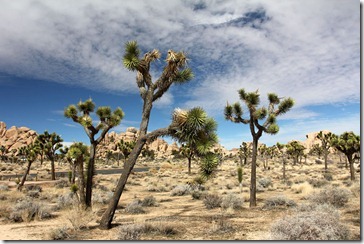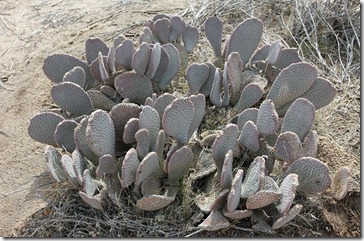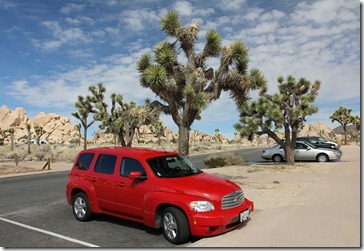Desert trip—day 2: Joshua Tree National Park
Day 2 of our trip was spent exploring Joshua Tree National Park. Like all desert parks in the West, it is enormous—more than 1200 square miles, an area about the size of Rhode Island—although only a small part is accessible by vehicle.
While the northern section of the park, with elevations up to 5000 feet, is located in the Mojave Desert, the southern section, below 3000 feet, is located in the Colorado Desert. The vegetation changes dramatically as you drive south. While the northern part is dominated by Joshua trees (Yucca brevifolia) and Mojave yuccas (Yucca schidigera), the vegetation in the southern part is characterized by jumping cholla (Cylindropuntia bigelovii) and ocotillo (Fouquieria splendens).
Our day began with a stop at the Oasis Visitor Center a couple of miles southeast of the town of Twentynine Palms. This visitor center has a beautiful cactus garden as well a well-stocked bookstore. Behind the visitor center is the Oasis of Mara, easily spotted by the stands of California fan palms (Washingtonia filifera). An interpretive trail runs through the heart of this historic place.
 |
| Cactus garden outside the Oasis Visitor Center |
 |
| Compass barrel cactus (Ferocactus cylindraceus) at Oasis Visitor Center |
 |
| Old man prickly pear (Opuntia erinacea) and Mojave yucca (Yucca schidigera), both native to Joshua Tree NP and found in many places in the northwestern part of the park |
 |
| California fan palms (Washingtonia filifera) at the Oasis of Mara right outside the Oasis Visitor Center |
After spending a good hour at the Visitor Center (and refilling our water bottles—always a good idea in the desert), we headed to Keys View, at 5185 feet the highest car-accessible point in the park. This overlook offers stunning views of the Salton Sea and the Coachella Valley, with the snow-covered peak of 11,500 foot San Gorgonio providing a stunning backdrop.
To get to Keys Valley, you first drive through the Queen Valley with its expansive Joshua tree forests and turn left onto Keys Valley Road which has even denser stands. Even if you’ve never been here before, the area may seem familiar—many car commercials have been filmed here.
 |
| Joshua trees (Yucca brevifolia) in the Queen Valley |
The Joshua tree (Yucca brevifolia) is the largest of the yuccas, with a height of up to 40 feet. It only grows in the Mojave Desert of southwest California, Nevada, Utah and Arizona, at elevations from 2,000 to 6,000 feet where the annual precipitation is 6 to 8 inches. The name is said to come from Mormon pioneers who, crossing the Mojave Desert on the Old Spanish Trail, named it after prophet Joshua because they felt the plants were waving them on toward the promised land.
 |
| Young Joshua tree on the left and older (branched) on the right |
Joshua trees grow about 3 inches a year in the first 10 years, after that about 1.5 inches a year. While that may seem glacially slow, it is faster than other desert dwellers, like the saguaro cactus of the Sonoran Desert.
 |
| Keys View road |
Joshua trees are single-trunked until they begin to flower. Experts now think that flowering occurs when the growing points are damaged by freezing. The plant’s survival response is to produce flowers (and hopefully seeds if pollination is successful). After the flowers and seeds have fallen off, branches start to develop from the same points where the flowers had been.
 |
| Keys View road from Keys View |
After enjoying the view from Keys View (where we saw patches of snow on the ground) and stopping a few times to take photos, we headed to Hidden Valley, in the old days a popular hideout for cattle rustlers. This easy trail is my favorite walk in the park. It loops through a valley enclosed by stunning rock formations, very popular with mountain climbers. The vegetation is quite varied here, ranging from scrub oaks (Quercus berberidifolia) and pinyon pines (Pinus monophylla), Mojave yucca (Yucca schidigera) and Parry’s beargrass (Nolina parryii), beaver tail (Opuntia basilaris) and old man prickly pear (Opuntia erinacea), to—of course—Joshua tree.
 |
| Beaver tail prickly pear (Opuntia basilaris) at Hidden Valley |
 |
| Rock formations in Hidden Valley and mare’s tail clouds |
 |
| Rock climbers |
 |
| Rock formations and dead tree in Hidden Valley |
 |
| Grass growing in a crack |
After our walk, we had a late lunch at the Hidden Valley picnic area. It has got to be one of the most beautiful places in all of California for al fresco eating!
 |
| Hidden Valley picnic area—this could be from a car commercial! |
After lunch we began to head south, leaving the Mojave Desert behind and entering the Colorado Desert. The biggest attraction in this part of the park is the Cholla Garden. The number of jumping chollas (Cylindropuntia bigelovii) here is breathtaking. Many of them already have flower buds and, according to a ranger we spoke to, will be in full bloom in three weeks (the flowers are greenish yellow). That should be a spectacular sight to see!
The stems of jumping chollas (sometimes also called “teddy-bear chollas” because they look so soft and cuddly but, of course, are anything but) detach very easily. The base of an adult plant is littered with dozens of detached segments which root very easily—in fact, this is the plant’s major form of propagation.
A word of warning: Cholla contact is painful. Since the tips are barbed, spines are very difficult to extract. Pliers are recommended, and loss of blood and flesh is virtually guaranteed. I had to stop myself more than once from getting too close to a cholla as I was photographing in the Cholla Garden!
 |
| Cholla Garden—this has got to be densest colony of jumping chollas (Cylindropuntia bigelovii) in the world |
 |
| New flower buds on jumping cholla |
 |
| Close-up of dramatic spination |
Our stop for the night is the town of Calipatria just south of the Salton Sea. Tomorrow we’ll explore around here before heading north to Palm Desert.
All posts about our trip:

Some of these photos are *amazing* -- just beautiful!
ReplyDelete"Pliers are recommended..." this makes me cringe. Some of my cactus seedlings are supposed to be cholla, so I may have some experience with this in the future. :-(
Alan, thank you for your kind words. We've had some very photogenic weather, and that certainly helps.
ReplyDeleteLuckily, all of us managed to get out of the Cholla Garden without getting jumped so no plier action was necessary.
Thoroughly enjoyable thread! Fantastic sceneries and photography!
ReplyDeleteThe huge Yucca brevifolias are stunning, and so does the rock formation at Hidden Valley.
Joshua Tree National Park has plenty of desert plant and animal life in it. It is a great place for auto tours as well with plenty of posted information at stops along the road.
ReplyDeleteI would love to cruise thru Joshua Tree NP on my motorcycle.
ReplyDelete